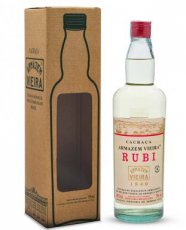Armazem Vieira Safira 40° Cachaca
May only be produced in Brazil. Used in cocktails such as Caipirinha and is the 4th best-selling beverage, after vodka, Korean soju and whiskey, in the world with more than 20 million sales per year. The secret of success is most likely its subtle sweetness and pleasant aroma.
Cachaça (also known as aguardente or pinga) is a Brazilian eau-de-vie made from sugarcane juice, just like rum ... But it is not, strictly speaking, rum, as the manufacturing techniques are very different. Santa Catarina is a small island in the south of Brazil and has been an important place of cachaça production since the 19th century.
The brand's name, Armazem Vieira, refers to a warehouse that once housed barrels of cachaça produced by local producers, among other goods. A historic building that bears witness to times gone by.
In 1985, the two founders of the brand, engineer and mixologist respectively, decided to revive this building after purchasing it. In collaboration with a local distiller, they produce their own cachaça.
The Safira cuvée from the Armazem Vieira brand presents fine woody flavors accompanied by very unique notes of brown sugar. Very tasty!
Has aged for three years in small 250-gallon garapa (grápia, garapeira) wood barrels - one of the 26 different types of wood used to ripen the cachaça in Brazil, and is known for its honey influence - this eau-de-vie has a delicious sweetness and a rare balance that makes it a real luxury indulgence
Food pairing
The basic ingredient of a lot of cocktails
Alcoholcontent
40 %vol
Caipirinha recipe
Caipirinha is the diminutive derived from the Brazilian word caipira. This is a Brazilian condescending term used to refer to unskilled (sometimes naive or even stupid) rural residents
Ingredients for one cocktail
Cachaça - 5 cl
Lime - 1 piece (you use a half)
Cane sugar - 2 tsp (white or sugar syrup)
crushed ice
Preparation
Wash the lime thoroughly and roll back and forth with the palm of the hand to loosen the juices.
Cut the lime in half and then in four, cut away the hard white fleece as much as possible and remove seeds that have a bitter taste
. Put the lime wedges with skin in a wide layer of glass, like a whiskey glass. Sprinkle cane sugar to taste.
Stamp the limes with a muddler, do not pound too hard, because the inside of the green skin (the white membrane) can release a bitter taste.
Fill the glass up to the edge with crushed or garted ice (not too fine).
Pour the ice with the cachaça and stir the cocktail well with a stirrer
Related products
 Abelha Gold 3Y Organic 38° cachaça€ 41.0070 clInventory: 1
Abelha Gold 3Y Organic 38° cachaça€ 41.0070 clInventory: 1 Cachaca 51 38°€ 25.001 LIn stock
Cachaca 51 38°€ 25.001 LIn stock Ypioca Prata Reserva 38° CachacaSold out70 cl
Ypioca Prata Reserva 38° CachacaSold out70 cl Armazem Veira Rubi 43° Cachaca€ 76.1870 clInventory: 3
Armazem Veira Rubi 43° Cachaca€ 76.1870 clInventory: 3

